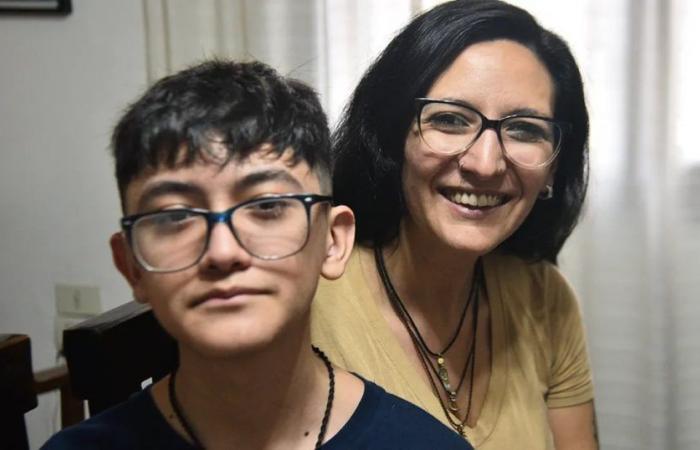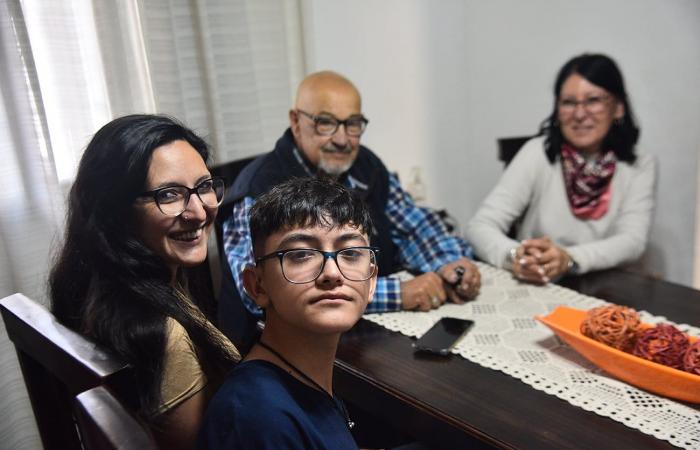The Córdoba teacher Sol Bianchi (37) created a solidarity network to help families obtain borrowed hearing aid supplies while they wait for social works to authorize new ones, or for those who cannot access the devices due to their high costs. . The ideal solution would be something else, but at least this help exists.
And that is precisely why it is called “I help you listen”, a project that arose from his own personal experience: his son Felipe (12), who has suffered from hearing loss since he was 2 years old, needs to renew his hearing aid and cannot do so until he the social work authorizes a cochlear implant.
Given this context, he decided to ask for help through social networks so that someone could lend his son a hearing aid. Her benefactor was Jorge, a man from Córdoba who, as soon as he found out about the need, contacted Sol to offer him her device.
“Felipe was diagnosed with bilateral hearing loss. He is now equipped with a hearing aid in his right ear, which needs to be renewed, and in the left he has severe hearing loss,” Sol said.
But until you have the implant, you cannot renew the hearing aid, because both must be compatible. Two months ago, the teacher presented the folder with the report and updated studies to the social work. Felipe is fit to undergo surgery, but the provider has to approve it.
The wait can last two years –said the mother–. If she decided not to wait, she would have to take legal action and the time could be extended. This delay hinders Felipe’s quality of life.
With these difficulties, he not only sought to solve the problem that arose with his son, but that gave him the impetus to connect with other people who are going through similar situations, from children to adults who need hearing aids or some other input, such as batteries or elastic headbands for children.
“Families cannot access it, because a new hearing aid costs around two million pesos. Not to mention an implant, which costs around 75 thousand dollars,” she said.
The network has already connected people from Córdoba, other provinces and even neighboring countries. Sol highlighted that there is a growing need on the part of families who need this type of help.
“Beyond the economic situation that families have to go through, there are gestures of kindness. And the greatest lesson I can leave my son is for him to be empathetic with others,” revealed this mother who raises Felipe alone with the help of her relatives.
How does it work
“I help you listen” works through Instagram. People can write down equipment to lend or donate through the available forms: “I want to lend” and “I need to borrow equipment.”
Then, Sol conducts a survey of the available equipment. These have to be prescribed and calibrated, and must be in good working condition. They can range from headphones, batteries and elastic headbands for children to chargers or any other device that may be useful.
Once the equipment is received, the donor is connected to the person who needs it. “We connect them not only through hearing aid inputs, but also through implant inputs, such as the coil cable that connects to the processor. If they are not using them, they can donate them,” he said.
In all cases, the teacher requests audiometry studies and receives advice from speech therapists, who offer to work voluntarily. Depending on the hearing loss the person has, it is the equipment that they will need and the one that they will be able to use.
“The specialists have to make a specific mold, calibrate it. The person is already in charge of that procedure. Families need advice and we provide them with information,” she noted.
The solidarity chain that Sol started has inspired people beyond the limits of Córdoba: a family from San Francisco will donate a hearing aid to a boy from Tigre, Buenos Aires; A Chilean family connected with another living in Canada, and the connections continue.
Contact: on Instagram “I help you listen” or by phone: +54 9 351 558-8185, Sol Bianchi.
“My dream is to listen to music”
Felipe is in the first year of high school and said that during primary school he was embarrassed to use his hearing aid. “When I started using it, I felt a big change: I heard better. I could chat at a family gathering or with my colleagues,” he said. He relies a lot on lip reading and is accompanied by therapists. Despite his hearing loss, he leads a normal life, accompanies his mother with the project and is also boy scout
Now, the only complication it has is with the dictations in classes. And if your hearing aid battery runs out, you should always have a spare on hand, because otherwise you will be left without the ability to listen. To make his hearing easier, he is waiting for the transplant that will give him the possibility of fulfilling his dream: listening to music.
“I lost my fear of the operation. “Every step we take is to be better and that is very nice, because I will be able to listen,” added the teenager.
In Argentina, according to data from the Argentine Society of Pediatrics (SAP), hearing loss affects between 700 and 2,100 children a year. And hearing disability constitutes 18% of disabilities, which is divided into 86.6% hearing difficulty and 13.4% deafness.
What is hearing loss?
The World Health Organization (WHO) defined hearing loss, deafness or hearing impairment as a sensory disorder that consists of the inability to hear sounds and that hinders the development of speech, language and communication. It can occur unilaterally, when it affects only one ear, or bilateral, when both ears are affected.
According to the WHO, the incidence of hearing loss is five in every thousand live births. The incidence of moderate hearing loss is three in every 1,009 newborns; Severe or profound hearing loss affects one in every thousand newborns, a figure that increases to between one and 10 in every 100 newborns with risk factors, and between one and two in every 50 newborns who are in intensive care units.
In this regard, Patricia Obertti, a graduate in Speech Therapy and certified in Auditory and Verbal Therapy (LSLS Cert. Tav), indicated that law 25,415, creating the National Program for Early Detection and Care of Hearing Loss within the scope of the Ministry of Health of The Nation requires early detection of hearing loss, one of the most frequent disorders.

With the single disability certificate, people can access 100% of the benefits that social works have the obligation to provide, whether for treatment or for hearing aids, implants and hearing aids, among other supplies free of charge.
“This is in theory; In practice it is something else, since it takes approximately a year for a child to get a cochlear implant, and it is known that the sooner you act, the better,” she stated.
Furthermore, he assured that with early detection, timely equipment and adequate therapy, a child with hearing loss can develop language at 4 or 5 years old, like a normal child.
“But a detection that can be done in the first months of life, in Argentina takes a year,” he noted. It takes a long time to get a hearing aid. The inputs are expensive, in dollars, because they are imported. Then they spend another few months in Customs and the majority of parents opt for an appeal for protection. “That takes a long time; and a year in the life of a child is a lot,” she said.
Prevention and tips
Obertti recommended that, in cases of hearing loss, it is best to treat it with professionals. “You have to take care of yourself and not worry. It is important to consult several times as soon as the newborn baby is diagnosed. There are many cases in which it takes a long time to make the query. They think that the child ‘is going to talk’, but he doesn’t speak and only makes gestures,” she explained.
For this reason, he advised acting before the age of 3, since with a cochlear implant and with adequate and timely treatments, the child’s quality of life improves. “There are children who hear great with hearing aids, but if they have a severe loss, the standard in the world is to perform the cochlear implant before one year of age,” said the specialist, one of the 20 experts in the country on auditory therapy in children. .
Solutions journalism
With this note, The voice begins a series of reports with the perspective of solutions journalism, seeking to promote actions that offer answers to social problems, on their scale and with their real scope. It is also an attempt to get out of the so-called “negativity bias” that we often incur when giving the news.








